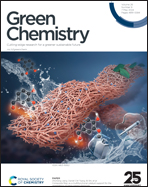Mechanochemical and aging-based reductive amination with chitosan and aldehydes affords high degree of substitution functional biopolymers†
Abstract
Chitosan is readily available from various biomass waste streams including crustaceans, cephalopods, insects, and fungus. The polymer possesses primary amine groups which are great handles for functionalization. Yet efficient functionalization with high degree of substitution is challenging to achieve via solvothermal methods due to limitations in chitosan solvation properties. Herein we report a mechanochemical and aging-based method directly addressing this point. Working in the solid phase helps stabilize the formation of Schiff bases from chitosan and aldehydes, affording a novel pathway to the green functionalization of chitosan by reductive alkylation, with unprecedentedly high degrees of substitution. The method showed great efficacy and compatibility for chitosan to be functionalized with 21 different aldehyde substrates and a low process mass intensity (PMI) of 36. This work also opens a new avenue for the development of mechanochemical and aging-based reductive amination transformations.

- This article is part of the themed collection: Green Chemistry 25th Anniversary Collection


 Please wait while we load your content...
Please wait while we load your content...